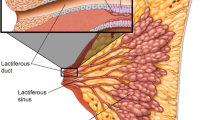Abstract
Nipple-sparing total mastectomy is performed for carefully selected oncological indications and is followed by immediate reconstruction. This chapter lists the indications, essential steps, common technical variations, and complications of the procedure. A detailed template operative dictation note is included.
Access provided by CONRICYT-eBooks. Download chapter PDF
Similar content being viewed by others
Keywords
- Nipple-sparing total mastectomy
- Total mastectomy
- Simple mastectomy
- Total glandular mastectomy
- Mastectomy
- Prophylactic mastectomy
- Breast
Indications
-
Desire for nipple preservation in a suitable candidate (sufficient distance from any pathology to the nipple must be attained), including:
-
DCIS not amenable to breast conservation or patient requesting mastectomy, in selected patients, to be followed with reconstruction
-
Breast cancer treatment in selected patients, to be followed with reconstruction
-
Prophylaxis of carcinoma in selected high-risk patients, to be followed with reconstruction
-
Essential Steps
-
1.
Confirm side of surgery.
-
2.
Sentinel lymph node (SLN) biopsy if indicated for staging of the axilla.
-
3.
Incision tailored to geometry of tumor/the breast – inframammary, lateral, and others.
-
4.
Develop skin flaps.
-
5.
Dissect ducts from the nipple.
-
6.
Biopsy terminal ducts of the nipple.
-
7.
Dissect the breast from the chest wall.
-
8.
Hemostasis under good visualization, lighted retractors are helpful.
-
9.
Orient specimen for pathology.
-
10.
Irrigate and pack wounds for hemostasis prior to reconstruction.
Note These Variations
-
Sentinel lymph node biopsy if patient has in situ or invasive breast carcinoma.
-
Prophylactic mastectomy is commonly bilateral.
Complications
-
Skin necrosis
-
Nipple necrosis
-
Seroma
-
Wound infection
-
Positive margin on the skin or nipple
Template Operative Dictation
Preoperative Diagnosis
Invasive carcinoma/DCIS/carcinoma prophylaxis of the left/right/bilateral breast(s).
Procedure
Left/right/bilateral nipple-sparing mastectomy.
Postoperative Diagnosis
Same.
Indications
If DCIS/invasive carcinoma: This ___-year-old female/male with a left/right breast mass/abnormality on mammogram that on workup with fine needle aspiration/biopsy was found to be ductal carcinoma in situ/invasive carcinoma.
If Prophylactic
This ___-year-old female/male was known to be at significantly high risk of breast cancer due to BRCA1/2 mutation/other. After discussion of options, the patient requested nipple-sparing mastectomy with immediate reconstruction.
Description of the Procedure
After identifying the patient and verifying the operative site, the patient was brought into the operating room. Time-outs were performed using both preinduction and pre-incision safety checklists to verify the correct patient, procedure, site, and additional critical information prior to beginning the procedure. General anesthesia was induced. All pressure points were appropriately padded. The left/right/bilateral breast(s) and axilla were then prepped and draped in the usual sterile fashion.
If sentinel lymph node biopsy was performed, include details.
A left/right inframammary/lateral/other skin incision was made. Skin flaps were developed using scissors/electrocautery superiorly to the clavicle, inferiorly to the inframammary skin fold, laterally to the latissimus dorsi, and medially to the sternal border. The breast was then removed from the chest wall using electrocautery, preserving/not preserving the pectoralis fascia. Perforating branches of the internal mammary vessels were/were not spared. Hemostasis was obtained with electrocautery. The specimen was oriented and submitted whole to pathology. A separate nipple margin was excised (a core of the central nipple was removed with this) and oriented for pathology. The wound was irrigated with sterile saline and packed. An identical procedure was performed on the right/left side. The operation was then passed on to plastic surgery for immediate reconstruction.
Author information
Authors and Affiliations
Corresponding author
Editor information
Editors and Affiliations
Rights and permissions
Copyright information
© 2017 Springer Science+Business Media, LLC
About this chapter
Cite this chapter
Groff, M.G., Sugg, S. (2017). Nipple-Sparing Total Mastectomy. In: Hoballah, J., Scott-Conner, C., Chong, H. (eds) Operative Dictations in General and Vascular Surgery. Springer, Cham. https://doi.org/10.1007/978-3-319-44797-1_144
Download citation
DOI: https://doi.org/10.1007/978-3-319-44797-1_144
Published:
Publisher Name: Springer, Cham
Print ISBN: 978-3-319-44795-7
Online ISBN: 978-3-319-44797-1
eBook Packages: MedicineMedicine (R0)




